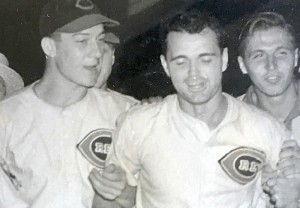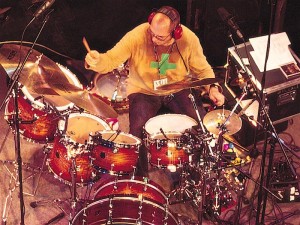Disciplined vs. Loosey-Goosey
 Here’s one person. Do you see part of yourself here?
Here’s one person. Do you see part of yourself here?
If you are the type person that keeps your nose to the grindstone and have worked on that one or two things for a week, break it up! Make your practice session a practice in diversity. Find something else to do. I suggest working on not thinking. Seriously! Play some notes and just listen to the notes – do not think about how you are playing the notes, do not think about your grip or posture or anything. Be empty. Just LISTEN to those (let’s say) 3 notes.
Then add more notes but remember those first three notes and go back to visit them every once in a while during that one singular sit down. Be a snowflake and enjoy the fall to ground.
This is a beginning of “practice playing.”
Here’s another person. Perhaps this is a better description of you?
On the other hand, if you are great at not thinking…. Now please, I’m not joking here, really I’m not. I’m actually this guy more than the disciplined guy. Anyway, if you are great at not thinking and simply reacting, then you are all over the fun of spacing out on your kit and messing around. You get distracted easily. Sometimes you never play at all, you just move everything around in your setup. Or other times you end up completely de-tuning your snare and then messing around with heads and tuning to get it back to something as good as it was, or even better. You have the ability to get lost when listening to music. Perhaps you get too lost when playing music? This is where playing with other people will help you. Other musicians playing with you in a live setting are checkpoints for what is good and what is not.
This is all I’m going to say at this time about Practice playing. I think the concept has to be taken on in baby steps. In general, if you lean more towards the first person noted here, good for you. You keep your goals in mind. However, try to set a goal of being THERE, in the moment; On your drums but also when listening. Stop following physical technique when you listen to music. Try to feel the music more.
Or conversely, if you are the space cadet, pick a weakness and spend part of your playing time working on that particular weakness. It could be independence or hands or one particular beat or groove, but work on these obstacles in earnest. Take that groove and learn to play it really stupidly slow. With a click in your ear.
For both of these types of people, record yourselves and judge harshly when you listen. The next rehearsal time will give you an opportunity to better yourself again! Just mix it up people! Have fun and don’t ever hurt yourself. Pain is an alert, remember that.
We all need to feed our head (and hearts) with music. Don’t forget that. There have been times in my life that I have been so upset that I denied myself one of the things I love the most; Playing music and listening to music. Why? Who knows. One general concept of living well holds true, and that is do diverse things. Don’t obsess on any singular thing. Stay open to change and embrace change. I’m now talking to myself here as much as you.
Another re-drilling of an earlier thread from earlier blog:
“Only become a musician if there is absolutely no other way you can make a living.” – Kirke Mecham on his life as a composer
My father in-law was a sculptor and art teacher. He put it this way; “If you are in the arts for fame or money you will have a very disappointing life. If you are in the arts to save your own life, then you will have very fulfilling life.”
I want to add “Ten Gold Stars of approval” to this statement.
This coming Friday and Saturday I’ll be attending PASIC again. If you are there and see me, come up and say hello! It’s a good scene at these conventions. I get a big boost being around so many PLUs! (People Like Us) I performed at PASIC in 2001. Man, time flies… Is it just me? Sometimes I feel like the only instance that time doesn’t fly is when I’m playing and lucky enough to be lost inside of what I am playing. Or with a loved one. Same thing.
x x x x x x x x x x x x x x x x x x x x x x x x x x x x x x x x x x x x x
I’m taking a break from the blog for a few weeks. I hope to return to writing in December. No promises, but I will get back sooner than later. If any of these blogs are any good (and I hope they are) you may wish to re-read some of them again. Or not. Just do something else! That’s what I’m doing by taking a break. Being contrary can lead to enlightenment, yes?
Thanks,
Bw
Baseball and Music
When I was nine years old, I got out of First Grade to attend the World Series with my Dad. It was 1961 and the Yankees were playing the Reds. My Reds got mauled by a Yankee team enjoying benchmark seasons from Roger Maris, (61 home runs), Mickey Mantle (56 dingers) not to mention Whitey Ford, Yogi Berra and more. The Yankees were Rock Stars. I wanted to be a baseball player and a drummer. I started my drum lessons with Jack Volk at nine years and continued with him through tenth grade in high school. (Mr. Volk was the ONLY teacher I had until my 17 year old one off lesson with Elvin plus then a couple of music schools). The grip that I learned from Jack Volk and the ensuing rudiments are still with me with no variation. Talk about good luck!!
Meanwhile, back in Little League ball, the pitchers began throwing curve balls to offset their fastballs. This is when I realized I had very limited ability in baseball. I walked onto the practice field and told my manager I was quitting. I was a drummer now. (I’m sure he was upset… Not. I was horrible)
I was two years into my drumming at twelve years old and playing in several bands. What I remember the most are two of them. “The Lonely Ones” (high schoolers playing songs Wipe Out, Devil With a Blue Dress and Glad All Over) was my first gig. Paid 10 bucks. The other was the YMCA Concert band, which two years later led to a YMCA National Concert Band that went to the ’68 Worlds Fair in Montreal. I was so shy I didn’t even know how to spell the word, but managed to kiss a pretty clarinetist on the bus coming home.
I strayed away from baseball after the Big Red Machine days in the mid ’70’s but as my career in music unfolded I began noticing the Zen-like abilities of baseball players. Watching Jose Altuve bat for the Astros in this current World Series is not unlike seeing Vinnie Colaiuta play with Herbie Hancock. Vinnie is a perfect example so I’m going with it. Both Jose and Vinnie are well trained, with so many gears of auto responses studied and embedded into their bodies, hearts and minds. Baseball has more rules about “what ifs” than any sport. It is a game of anticipation, not action. When the pitcher holds the ball (and the first baseman “adjusts himself”) the music is about to begin. The pitcher winds up and throws a small round ball and, if performed beautifully, the defence becomes a moving ballet – all dependent upon what the batter does when he swings. Ball hit to the infield? The catcher runs to back up first base as the right fielder also runs forward in case the ball gets loose. There’s a million things happening and you can’t see it all on TV. You have to be there.
Have you heard of the phrase “The Inside Job?” Athletic coaches and pro scouts have spoken of this in rating their players’ skills. The Inside Job is about things other than how fast, how athletic the player is, it is about the other half of what turns a gifted player into an All Star like Jose Altuve.
Do you acknowledge the inside job while playing in a band or a recording session, a rehearsal or jam session? It’s always there. Empathy will help get you there. The outer journey, the people you meet – the successes and the failures all contribute to you being you. The inner journey, how you feel as you travel through these experiences and how you integrate your lessons, contributes to your Inner Game. Being an All-Star depends on maintaining an active connection, or conduit, between all that you know and the ability to let go of all that same knowledge for that one moment when NOW is happening on the bandstand or on the playing field. When you hit the stage, you are in the batter’s box about to do a very difficult thing. Baseball fans watching this World Series have fallen in love with Jose Altuve, all 5’6” of him. He wasn’t a valued prospect. Scouts looked at his physical skills and undervalued him because he was undersized, but he has become one of the great ones. He may well win the league’s Most Valuable Player award, which is a stepping-stone to the Hall Of Fame! Altuve goes on the playing field and all that he knows and has done is in his back pocket, but he remains empty, waiting for the pitch to hit, or the ball to field. He spits out sunflower seeds constantly, no doubt one of his mechanisms to remain in the moment and keep his brain from thinking. Yes, the mind can be a terrible thing. That very moment of anticipation is where the gold is. Vinnie flies into a town, says hi to Herbie Hancock and they hit the stage. Brian Blade does the same with Wayne Shorter. This is no time to think. It is time to react and react honestly, as you.
If you’ve ever done a big gig, whether it’s that first gig or playing at Wembley, you should understand the nervous challenge that awaits you. Is Jose Altuve nervous in the World Series? Yes he probably is sort of, but he, Vinnie and other great ones have ways to turn that fear of failure into excitement, which creates greater awareness and alertness. Have you heard the story about Steve Gadd waiting to go on at a Modern Drummer Festival? Most of the drummers performing that day were preparing for their performance by doing exercises on their practice pads and getting loose. Working on relaxing. I’m told that Steve was standing off stage next to a rear curtain and snapping his fingers for the longest time. He was just working on the perfect tempo. He already had everything he needed to play well, he only need the tempo. That is one display of understanding the Inside Job.
If you can find a way to pursue all the knowledge that interests you and study hard, then you are heading to that place where these influences will end up being like clothes in your suitcase. Then, if you choose to, you can open them up and wear them.
Who are you listening to and how are they influencing you?
How does one practice for a future creative moment? This is one of my favourite topics that I discuss in lessons and I have a concept or two that helps you get there. I’m nervous and uncertain I can do it justice with only written words but I will try in future blogs. Let’s see how I feel next week, maybe it starts then. I await your reactions and comments to this.
Thanks,
Bw
Halloween. Really?
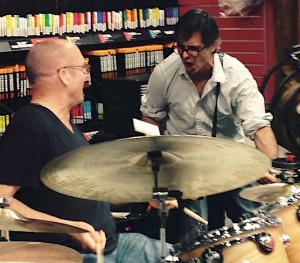 Forgive me, but I’d like to begin and again encourage people to play with other people. Everybody is making videos these days. So many drummers post videos of themselves playing alone on YouTube and Facebook. I wonder who these people are and why they would do this. Is this “Look what I can do”, or “Look how easy I can make this look?” “Look.” “LOOK!!” Or is it meant to teach? What is gained by making a video of you only to receive empty replies such as “likes” or “Wow, I’ll never be able to do that.” For me, as a viewer on Facebook, I have an empty feeling when I add my “like” or even “love’ to a musician I wish to encourage. I also feel a bit empty when I receive a like. If you are posting to teach something, does “like” work for you? How do you know if the light bulb has gone off in the viewer’s head? Social media concerns me. Am I showing my age? “Get off my lawn!”
Forgive me, but I’d like to begin and again encourage people to play with other people. Everybody is making videos these days. So many drummers post videos of themselves playing alone on YouTube and Facebook. I wonder who these people are and why they would do this. Is this “Look what I can do”, or “Look how easy I can make this look?” “Look.” “LOOK!!” Or is it meant to teach? What is gained by making a video of you only to receive empty replies such as “likes” or “Wow, I’ll never be able to do that.” For me, as a viewer on Facebook, I have an empty feeling when I add my “like” or even “love’ to a musician I wish to encourage. I also feel a bit empty when I receive a like. If you are posting to teach something, does “like” work for you? How do you know if the light bulb has gone off in the viewer’s head? Social media concerns me. Am I showing my age? “Get off my lawn!”
Sharing brings happiness. It is a crucial expression of love. It’s not so good if you are only in your own personal bubble and not playing with others. It really is awesome when a band member is looking back at you with such intensity as you OWN the groove and you’ve got the entire band in your care and they are as happy as humanly possible.
Halloween is coming up in a week or so and it has led me to thoughts about drummers that work on fills in isolation from groove or music. Drummers that only work on the fills themselves are playing a facsimile of music, just like a Halloween costume. I mean, “Wow, listen to this guy playing a Bonham (Batman) fill!” Who’s Captain America? Vinnie or Gadd? When I get better maybe I could be Ant-Man. Love that guy! Be careful about which licks you get friendly with. You might not want to wear that costume on all of your gigs. If fills are words spoken, rather than notes played, and if those same words are not relevant to what else is being said, then those words are mumbo-jumbo! Nonsense really. I’m talking about CONTEXT. I know plenty of swear words in French – some real nasty ones too that even the French themselves won’t say out loud. Does that mean I speak French?
Work on fills if that is what you want to do, but study how to get into them and out of them without ripples or without speed bumps, definitely without pooping in your pants. Continually check out how to place those movements in context, perhaps with other objects instead of sticks (mallets? brushes?) Or dynamics. Tempos.
I promised some snippets about drum gear. I’ll start with what is an odd irritation to me. People, stop listening with your eyes! I’m not talking about judging a drum track in the studio by watching it to see if it lines up with a perfect grid. I’m talking about seeing a drum with a deep shell and saying, “man, I want some deep drums!” Really?
It is my opinion that drum manufacturers or designers that use their ears to design drums (perhaps with less marketing concerns) would agree with me that a deep drum does not mean a deeper sounding drum. My 4×15 DW Maple mahogany, or same size Craviotto Walnut, or same size 1920s Ludwig standard brass ALL have more bottom than any 6.5 X 14 snare drum because less deep shells resonate longer. The top and bottom heads enjoy each other’s company more! If you really want deep go an inch wider! With my own personal taste or choice, I hardly ever go lower than 5.5 deep snares because I LIKE that “oomph” on the bottom, though I enjoy my Joyful Noise 6.5×14 brass. My 6.5s have more mid frequencies than thinner shelled snares. I suppose this could be the way I tune. Yeah, it’s only music and there are always exceptions to any rule in music. Let’s talk about toms. The 10×10, 12×12 will sustain less than 7×10 and 8×12 sizes, right? Right! The floor toms tend to be longer and that is a good thing – because the notes are bigger and sustain longer due to the size of the drumhead! Unless it is a solo drum performance (and don’t get me started on that) you can’t have a floor tom that sustains forever. This is why speed metal drummers have toms that are deep in depth. They play a kazillion notes so they need attack and not so much sustain. Of course, 10×10 & 12×12 toms look cool, or at least they once did. There’s more to this topic of course but I at least wanted to touch upon it.
“There are still so many beautiful things to be said in C major.”
-Sergei Prokofiev
I feel this way about 4/4. Thanks so much for your responses and shares.
Bw
The Hard Part
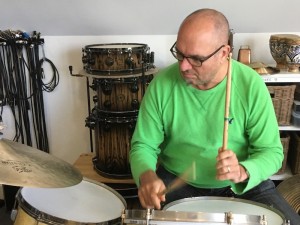 Question: “What was it like getting back into drumming after a hiatus?”
Question: “What was it like getting back into drumming after a hiatus?”
I kept in touch with my drums because I love them. Seeing them cheered me up and tapping them as I walked by reminded me of their possibilities. Approximately once per week I would sit down and try to play something beautiful, and would stay there, noodling around, until I did just that.
Fundamentals don’t leave you as quickly as speedy chops. I could always play a pop (non-notey) gig because my fundamentals are sound. The bits of work that I got, such as recording the Chris Shinn record did not involve playing for long periods of time. I was done once we had a take and that went quickly. I‘d bet that back then a one-hour show would’ve worn me out! My saviour was the Big Time stuff that I teach in that DVD. Mechanisms. The fact that my grip is super easy also helped. Honestly, currently having less hand and feet chops than I once had is interesting. I loved Paul Motian’s playing, his hands? Elvin Jones, his hands? Ed Blackwell is another beautiful non-chopsy drummer. Ringo!! They are all so much more highly skilled than might appear to a 12 year-old aspiring drummer. Could they play a double stroke roll, open to closed until it is a gorgeous long note, and then back out to open? It doesn’t appear so to me. Their special kind of technique was the fast connection from their ears to their entire body. They played musically and I believe the degree of difficulty was their inner gyroscope, which was highly evolved. Plus their aesthetic was solid, unwavering. Let’s face it; Elvin takes the cake with inner gyroscope chops. Ringo owns the aesthetic arena. His choices are genius. If Mozart played the drums he would’ve played like Ringo. My favourites!
I think that is one reason I will frequently reach for a tambourine or shaker mallet in my right hand instead of a drumstick at times. Having a limitation can be freeing in terms of creativity. This is also why I dropped the two-rack tom setup. It is simply too easy to repeat things from one drum to the next when they are right next to each other. That extra drum (cowbell) stares at me, “Play me, you fool!” When I played with Chris Whitley in the 90s, I wanted each note to count yet not have too many notes, so I had three toms in a triangle left of hi hat, middle and right. This way I could never go all Billy Cobham on his music, yet now looking back, I did go Cobham on him at times and I regret that.
But all this talking about me doesn’t necessarily help the person that asked about how to get back from a hiatus. I’m going to guess the REAL question being asked is “How can I get back into the drums?” I’m thinking some of you at times are not feeling it. You sit down and practice and leave the session feeling empty – untalented – confused.
First of all, most drummers that are in this (unfortunate) spot have technical problems. It is more often than not hands. Grip. Yet facing the grip problem is such a big mountain to climb, it is usually left ignored. So, if your hands hurt, or you simply can’t play what you want to be able to play? Take ONE lesson with someone who sounds like they have a great grip. Then try what they said. If it doesn’t work for you, go have another lesson with another professional. If you want to have that one lesson with me, I’m here and available. I believe strongly in my grip.
BUT, in spite of not fast and easy hands, anyone can move forward with what you’ve got and make practice fun. Music can be made with an absolutely crappy grip! I’m going to share a skill that is, like a good grip, not real easy but it enables you to make music when you play. When you sit down at the kit, do not try to be someone else. Do not play any licks that you have worked on or want to work on. Play three notes and go somewhere with those three crappy little notes. Be responsible. You know how to cook a dinner for yourself? OK, this means you know how to make something happen with three notes. The hard part is being connected to yourself, and not the fictitious drummer that you think you are.
<This is so hard to type out – goes back to Thelonious Monk’s quote, which I always thought was “Talking about music is like singing about math” but according to Google, it is more likely to have been “Writing about music is like dancing about architecture.”>
Consider re-reading the proceeding paragraph. Maybe something will click. Either way, I’m going to keep trying to get the words that best explain what I’m trying to share.
Follow what turns you on. Do what is fun to do! I’ve always loved tuning drums and finding out what they can and can’t do. Hours can pass by when I’m testing new sounds. One bizarre effort was seeing what happens when a bunch of BBs are placed inside a floor tom. Or potato chips. But that’s just me and yes, I’m an idiot. Another thing I’ve done in my practice room is messing around with alternative tunings and comparing different DW wood types. I’ve got lake birch (super rare kit), maple mahogany, jazz series, pure maple collectors, all spruce, and mahogany with spruce. I also enjoy playing my Leedy pieced together from different eras drum set; 50’s 12×24, 30s 8×12 and 40’s 12×15 converted snare. All of these drums have a thing. Rogers drums are so great. Did you know that I played the soundtrack to Steven Seagal’s Under Siege with a 20, 12, 16 + 14 snare Rogers kit? I suppose I’ve never met a drum I didn’t like to play… or tabletop or steering wheel. Next week, I’ll talk about my gear and share a few things I’ve learned.
Thanks,
Bw
Goin’ Fishing
 I was under the weather last week with a bad cold. I am still under the weather this week and it’s worse, now a sinus infection. Ugh. The good news is I’m taking antibiotics and hope in the coming days to be rid of the worst sinus infection of my life! But my eyes hurt. My head hurts. On top of this my house has a badly leaking roof and it just rained all day yesterday. Lots of rain. My nose and my ceiling are both leaking! Now, back to you as I answer some of your comments and questions.
I was under the weather last week with a bad cold. I am still under the weather this week and it’s worse, now a sinus infection. Ugh. The good news is I’m taking antibiotics and hope in the coming days to be rid of the worst sinus infection of my life! But my eyes hurt. My head hurts. On top of this my house has a badly leaking roof and it just rained all day yesterday. Lots of rain. My nose and my ceiling are both leaking! Now, back to you as I answer some of your comments and questions.
Big Time. Many times in my instructional “Big Time” as well as numerous clinics or appearances, I’ve talked about playing the space between the notes. About loving that space. Big Time teaches how to be self reliant in playing the space, by wiggling in time, breathing in time. Sometimes the rest of the band or at least a crucial player has time that is simply too fluid and yet the drummer needs to still be steady, perhaps because it’s a recording and your performance is the only one, as drummer, kept on the record from that particular session, or maybe simply to keep the band from finishing a song 5 or more BPMs faster than when it started! There have been times when I’ve just not felt right while playing and I needed something more to “hypnotize” me into playing well again. That’s what “Big Time” is about, and more.
I believe that many of us, when in turmoil during a composition, we end up playing more notes to try to get comfortable. Where did that pocket go? My solution is to learn to play the spaces with a quiet sound because nobody wants to hear all of those notes. Big Time. Check it out. Study with me and we will go through it together.
About Chapin and Tony: No, I have not mentioned the Chapin Tony books because, no doubt great as they are, they did not work for me personally. It felt too mental to me and I couldn’t see music within it. It’s like my book analogy in a blog a few weeks ago. One person loved Treasure Island and the next might find it dumb or simply not interesting. I studied Tony deeply on my own, using Alan Dawson’s emphasis on Paradiddles mostly and how they can be on the drum set. Like Keith Moon, Tony had an aggression that was beautiful. There are never enough words to describe and show appreciation for Tony Williams.
More about James Brown: You COULD imagine you are on a gig doing JB songs (or better yet, you really could be doing it real life with friends or co-workers) but imagine there is only one guitar. Now you have to place those extra funky notes on the hi-hat, or elsewhere on the kit to get the groove. Practicing busy things on the gig can be a good thing so long as you aren’t spoiling everybody else’s fun.
One favourite practice moment I highly recommend:
Do any of you ever “go fishing” on your drum set? I hope so! It can lead to valuable improvements in the way you approach your instrument. Sit down and play something unimportant – unrelated to anything of this world. Space out and see what comes next. Do it every time you “practice.” Be an explorer!
I often think about the drummers I’ve met along my teaching path. Thank you for following my blog and spreading the word.
Bw
Your Fully Integrated Beauty
 I love reading creative quotes from interesting people and since I’m somewhat brain dead with flu, I thought this was a fun way to splatter some thoughts your way. Feel free to share some of your own thoughts or stories after reading, and don’t forget to tip your waiters.
I love reading creative quotes from interesting people and since I’m somewhat brain dead with flu, I thought this was a fun way to splatter some thoughts your way. Feel free to share some of your own thoughts or stories after reading, and don’t forget to tip your waiters.
“One of the perks of being an unemployed musician is that you get to play much less bad music.” -Jack Daney
So true! I wrote a piece about this in Modern Drummer Magazine suggesting that non-professionals might be enjoying their music more than professionals. Sometimes I wonder how a musician touring with <fill in name of despised artist here> feels. Worse than playing the show could be sitting on the bus with them and not primal screaming. I was never a true professional and I’m certain that hurt me financially. My problem is even if I try to act that I like something, my obviously lame-ass poker face shows exactly what I’m feeling most of the time. I’ve just realized more than ever now, I am a musical snob. Is this a price I pay to have my own aesthetic in music, in knowing what I like and don’t like? Or am I a dick?
Q) How do you get a musician to complain? A) Get him a gig.
The drummer drives. Everybody else rides!” -Panama Francis
We ALL know that, but it is my belief that many others in the band play the drums. Sometimes the only thing the drummer has to do is watch the store.
“Jazz is the only music in which the same note can be played night after night but differently each time.” – Ornette Coleman
If you think all notes are the same then I do not wish to play with you. For example, a note leading into a downbeat is very different than the note following that same downbeat. The great drummer, Shelly Manne, spoke of jazz musicians, “We never play anything the same way once.” Obviously he had a sense of humour. I think nuance is underrated.
“I’m too old to pimp, and too young to die, so I’m just gon’ keep playin’.” – Clark Terry
And Clark Terry did just that. I remember playing a couple a wedding gigs (called club dates in NYC) with him. We were all shocked and thrilled someone of his stature, a genius player and composer, would work on our lowly gig. He played great of course and his attitude was perfect – no complaining. It was a true lesson in professionalism and humility.
“A great teacher is one who realizes that he himself is also a student and whose goal is not to dictate the answers, but to stimulate his students creativity enough so that they go out and find the answers themselves.” – Herbie Hancock
This is always what I hope to achieve when trying to help someone. The good news is the teacher benefits as well.
“After silence, that which comes nearest to expressing the inexpressible is music.” -Aldous Huxley
Didn’t Thelonius Monk say something like “Talking about music is like singing about math?” Expressing the inexpressible. Even those three words bring upon a feeling of space. Beautiful space. God. Musicians that come to mind quickly? Russian pianists Emil Gilels and Vlad Horowitz. Keith Jarrett. Wayne Shorter. John McLaughlin. Samuel Barber’s Adagio for Strings is a sure fire tearjerker. Why do I attach “inexpressible” to mostly instrumental music, not songs with words? Then again, Tom Waits’ album “Bone Machine” and much of the early-ish Radiohead stuff gives me a feeling of …what is it?…pure feelings without judgement? But instrumentals say more by literally not saying anything.
“If I could play like Wynton (Marsalis), I wouldn’t play like Wynton.” – Chet Baker
I feel this way about Wynton also, as well as some drummers. I hear the notes but it doesn’t butter my muffin. All artists have an aesthetic, a filter through which art is compared and kept as influence or discarded. What are yours? Who do you keep? Who do you discard? As you develop as a musician, your musical vocabulary becomes an integral part of you. Eventually it can’t be turned off. It is who you ARE. Think about that and develop yourself towards beauty. Your fully integrated beauty!
Thanks
Bw
Music Is A Very Hard Instrument
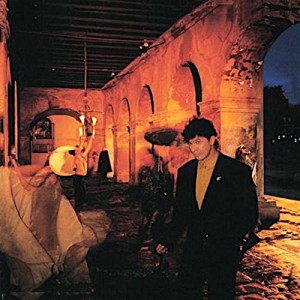 First a note. Quite a few people have left excellent suggestions of topics for me to cover in this blog. If you would like to add to the list of recommended topics, sign in at billyward.com – and welcome to our group! Also, about the website – Thank you to all of you who generously shared on the questionnaire at the website. I’ve been embarrassingly slow to respond to the almost 100 responses. Actually I’ve been completely inactive in getting back to you! I hope to help everyone who requests help. I’m going to be hitting these questionnaires and answering many of you in the coming month and if some of you wish to study privately with me we will proceed.
First a note. Quite a few people have left excellent suggestions of topics for me to cover in this blog. If you would like to add to the list of recommended topics, sign in at billyward.com – and welcome to our group! Also, about the website – Thank you to all of you who generously shared on the questionnaire at the website. I’ve been embarrassingly slow to respond to the almost 100 responses. Actually I’ve been completely inactive in getting back to you! I hope to help everyone who requests help. I’m going to be hitting these questionnaires and answering many of you in the coming month and if some of you wish to study privately with me we will proceed.
Neil, a very talented pro drummer who took a lesson with me asked that I share more about my track on Robbie Robertson’s album “Storyville.” I’m uncertain how many lessons lie within this story. I know there is one lesson for sure. Hopefully this is more than just a story to you.
This happened some time after I was in The Knack and before working with Chris Whitley as well as continuing numerous Gary Chang film sessions. Gary Chang had worked with Robbie on his first album that Daniel Lanois produced and Gary was instrumental in my meeting and then playing with Robbie. Apparently Gary called Robbie and basically said, “You’re an A-hole if you don’t check out this drummer from New York, Billy Ward.” Robbie responded with ‘send me some things you’ve done’. I sent him a cassette (cassettes!) of me with Bill Evans Supergroup and a punk song from The Beeks, a band I was a part of 8 years earlier that played at CBGBs. The Beeks’ song was titled “Gotta Be A Man.” A few days later my phone rang: “Billy, this is Robbie Robertson. So, Gotta Be A Man, huh?”
We started jamming music (pre-production) that might or might not eventually end up on his second record, “Storyville”, for about 6 weeks.
I was uncomfortable during Robbie Robertson’s “Hold Back The Dawn” session. The morning of the session I was loading my cymbal bag into the back of my Toyota pickup and there on the street was Bass, my beloved kitty, obviously dead. We had just moved to LA and Bass went out that first night and must’ve been hit by a car. I was sharing my residence with Mark Craney, who became such a cherished friend. Mark said,” “Go to your session, I’ll take care of his body.” Tears were shed. Many of them. I was hysterical!
Upon arriving at the Village Recorder in Santa Monica I told the engineer what happened. The session itself began with them playing a wonderful take of “Hold Back The Dawn” with Ginger Baker on drums. I had worked for months with Robbie in preproduction of this record but we never worked on HBTD. This was the first time I heard this song. They didn’t say anything after the song ended and I said, “That’s Ginger and he sounds f..’n great. He really did. It was moody, smoky and had his usual floppy kind of touch that I’m fond of. I didn’t know why they were playing this for me. They said, “We want your energy on it.” I was shocked.
We began recording. The producer wanted specific notes. “Not like the demo” were the words between several takes. Additionally, between several takes, Robbie wanted me to “just go for it.” Finally, after battling these two different approaches within a single song I started finding the right place and they were right. It needed both emotional views. (It’s important to share that while tracking I was thinking, “This is for you, Bassy. If only you had not been out at dawn this morning!”) It was then the producer, Stephen Hague said “That’s it Billy, but it still feels just a bit too muscular. Try to imagine that your favourite cat or dog just died.” Nobody knew about Bass except the engineer. I walked out of the Village Recorder saying I needed air and walked around the block trying to straighten out my head. I was literally talking out loud to myself , possibly the only time I did that! It was then that I realized a truth that I will always now remember; Music only relates to other music, not to loved cats that just died. I wasted many takes trying to play for dead Bassy instead of playing for the song!
Now that it is done, I always think of Bass when I hear any part of that song. Now my performance was for him. Thanks to the bassist, there was some degree of difficulty with timing, but really my challenge that day was emotional. That track and that experience is one I’m proud of. Stephen Hague was patient and correct in his approach to the song and Robbie wanted to feel it, after all, he was used to hearing great drum performances by Levon Helm! For me, the quality of this record speaks for how talented Robbie and Stephen were. RR gossip? I can say this, during pre-pro as well as during recording, Robbie played great. He is a monster player! It was like James Brown-land at times when we jammed. Other times it was moody, grooving or slinky stuff.
I’ve had a few gigs where I felt everything I had ever experienced was pouring into my playing. Working with Robbie was one of them. I loved the jamming we did in preproduction! He’d work up a sweat and start standing as we cooked the groove, grinning from ear to ear. We did another song also that day, just the two of us, and RR later said it was in some movie. I’ve never heard it since he gave me a cassette of our rough mix and that was lost. Shortly after my session, Robbie recommended me to play with Chris Whitley and though Chris never became mainstream, it was challenging music with an incredible artist.
BTW, playing “like you mean it” does not always mean loud and proud.
And finally, have you been playing the game of “Find The Drummer” in your listening?
“To excel, strong you must be.” -Yoda.
Thanks,
Bw
It was a breakthrough for me when I realised that great beats don’t all have to contain busy hi hat and snare notes. The drums are not the only instrument in a band that supplies rhythm to a song! This is one reason why I believe too much time alone on the drum set, without band mates, can turn your playing toward destructive tendencies. I am a rock. I am an island. Well, nobody will want to play with you if you force too many notes on them. It’s like a pianist who plays bass with his left hand on the piano, he sure sounds great playing alone during cocktail hour, but his bass player hates him because he is playing all the notes.
There is also a bit of danger in playing with recordings. The recordings are in stone – their timing won’t change and your playing will not influence the feel of the song. When I play to tracks at clinics I always feel like I am simulating sex. Honestly, I’m trying to regurgitate a moment that happened previously. You think your timing is good based on playing with recordings? Playing with human beings who are perhaps not as experienced or more experienced is more of the test, and playing with people teaches you lessons that last a lifetime. Find people to play with! Doesn’t matter what the music is. I played “oompah beats” in odd time sigs when I gigged at a Greek restaurant a long time ago. You hate the music that is available to you? Well, if it disturbs you so much that you deny yourself a learning experience (and one that will likely be a fun one too) then maybe you should move away from drumming. Maybe you really don’t have the natural instincts to push forward no matter what. Playing too much alone when you are in the process of discovering who and what you are is insane. Push yourself to socialize with other musicians. Play with anyone and everyone!
One thing to get into when alone? Of course this is shown quite a bit in my instructional “Big Time”. Study patterns with displaced backbeats. Then record yourself and listen harshly. Also record the same WITH a metronome and then listen. An obvious example is Billy Joel’s “Just The Way You Are.” Liberty’s famous pattern shows that each note is a part of another bigger pattern played by the entire band. (Just like ourselves, we are all beings in the universe and so are our notes.)
Advanced players: Learn to lean into a bass, guitar or piano note that you are NOT playing, as if you yourself played that note. Get it? I’ll try to explain more. In the Billy Joel song I mentioned, the push on the snare going into “4”. In the studio, many of us commonly call a note that arrives before a downbeat a “push.” The push is completed with the bass drum, which is playing what the snare normally would be playing – the “4”.
Also, in the same song, the piano lick at top and throughout the song pushes into “2”. So the piano pushes into “2” and the snare pushes into “4”. All the same! When playing that song, treat the piano (in your ears) as if you are playing it. In other words, make it part of your pattern just as the bass drum and snare are part of the pattern on “4”. The groove will be stronger then.
Playing grooves with fewer notes is only going to be great if you are also listening to the other instruments playing contrasting rhythms. This is how you get simple and more beautiful in music, by listening and absorbing. I confess, I have been bad and I know you have also. You see, as much as I’ve listened to James Brown and the Meters, it has not been enough.
James Brown. The (picking) guitars are mostly playing congas and the ones playing chords are playing snare drums! Is the hi-hat covering the “chirpy” role in the funk groove, or is it guitars – or keyboards. Possibly it’s the brass doing the syncopation and the hats are simply offering a backdrop to the funk.
The Meters. How is it that we feel that backbeat but the snare is not playing it? Ziggy treats the hat like a drum. Yay! Can I get that swampy in my feel when I play the notes? Record yourself.
In general, when listening to music, play the game of “WHO’S PLAYING DRUMS? It isn’t always the drummer offering the most exciting rhythms. Also, please join my forum at billyward.com. It is being reborn from a long time ago. We would like to know you.
Thanks,
BW
All You Need Is Love
 I have plenty of problems. You see, when I am driving through a parking lot and looking for a space to park, if there are lots of available spaces, I can’t decide where to park. I keep driving around until my wife says, “That’s the one!” Then I thank her and park the damn car. Menus do the same thing to me. A large menu at a restaurant will also keep me spinning with no decision. I usually end up asking the waiter what they recommend and choose from that.
I have plenty of problems. You see, when I am driving through a parking lot and looking for a space to park, if there are lots of available spaces, I can’t decide where to park. I keep driving around until my wife says, “That’s the one!” Then I thank her and park the damn car. Menus do the same thing to me. A large menu at a restaurant will also keep me spinning with no decision. I usually end up asking the waiter what they recommend and choose from that.
That’s why, after posting a blog, I live in uncertainty. “What in the world should the next one be?” And then I get all super critical of myself. “No, that topic is tired”…or “This one is much too heavy” or one that we all share in one form or another, “I’m not good enough to write that.”
Well? My mentor (and friend) in all things Internet, Toby Goodman, assists me with my website and continually kicks me in the arse. He’s English. I love to hear him say “twitter”. Brits enunciate their “t”s like nobody! Anyway, Toby suggested I put the topics out there in front of me. And then I should throw a dart and get to it! Toby, it’s not working! I have too much FUD – fear, uncertainty, doubt.
I’ve now realized the answer to that question lies in you. Yeah, you. I’m asking you to tell me what you want. I want to select from your menu! Do you want to hear more about something that is in my vids? Or my book? Or someone else’s vids? Or something that happened to you on the bandstand? In rehearsal? Or is it something that was in your head when you woke up yesterday? (Yeah, that last one might be the scariest)
Staying in tune with this thread of us communicating, today the forum at my website has been reactivated so you can sign in and speak directly with me there. This forum started before Facebook and was very active – 2k per day visitors! Let’s compare private forums vs. Facebook. I had thoughts of sticking with FB but they can change their rules and your posts disappear in a New York minute. Also, a forum is able to maintain threads of interest. All the past posts have been saved at the Billy Ward Forum and there are incredible topics available for you to read and discuss. Thousands of posts! If you were a part of our family before, please go and sign up with your old ID or with a new one and give us a brief introduction about yourself! I look forward to speaking honestly and sharing our truths and doubts with each other. Don’t forget to leave a topic or two for me.
Before closing this week’s blog I wish to acknowledge one last thing. Lately there is WAY too much trouble in the world with fires, storms, earthquakes and people and countries threatening each other. My hope is that we as a people (and I mean all people) get it into our hearts that we have more in common with each other than the reverse. I’m writing these words on Monday September 11th 2017. I will never forget the anguish and terror that made 9/11 a shivering memory. I had just begun a clinic tour with John Good from DW and after a heart-wrenching decision making, I chose to continue on with John while my wife was in NYC less than one mile from the WTC. Because of the ensuing breakdown of transportation and rampant fear that was chilling our country, John and my travels included taking a taxi from Pittsburgh to Canton Ohio as well as driving 10 hours to the next show because of cancelled flights. What held me together…for both of us really, was music. We always centred most of our listening on The Beatles. There was lots of singing to music as well as crying in our car as we covered the entire US – east to west. So today, for John and me, remembering 9/11 involves “Beatles day”. Let’s all listen to more music and less hateful speech. Deeds will take away hate and bias, not words.
All You Need Is Love
Thanks,
BW
How I Got Here, Technique-wise, Part 3 of 3
I was a practicing monkey in my early 20s, playing 8 hours a day while dropping out of two music schools. Not being in a band tilted my attention to freer forms of music, Coltrane, Anthony Braxton and others. Have you heard Jack DeJohnette play drum solos? I was into that kind of thing. I even performed a solo drum concert at North Texas State after dropping out. Looking back on that, all I see is ….big balls, LOL!
But speed for its own sake was of little interest to me. Seeing how my favorite drummers of that time (Nigel, Ginger, Ringo, Blakey, Elvin, Jack, Mel) were not particularly chopsy with their hands directed me to focus on other areas. 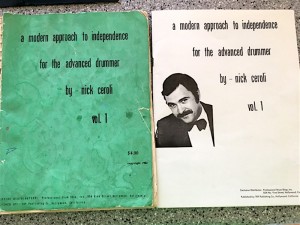
I wanted my technique to work toward absolute control of tone and what I am going to call “balance” which is… Making mus
ic up on the spot, and being able to get those barely-just-thought-of-notes out in some semblance of order, without the entire thing falling apart. I think balanc
is one of the hardest things to do. It starts with attaining comfort with your left hand and right foot as well as your right hand and your left foot.
This last book pictured here helped launched me toward developing better balance on the drum set. “Independence for The Modern Drummer” by Nick Ceroli. I never heard Nick play anything in person but he was very highly respected by all the pro drummers of that time. Nick’s main gig was The Tijuana Brass. This book is quite similar to Ted Reed’s Syncopation in that you add bass and hi-hat on all the exercises. But the exercises get more difficult. I swear to you, I would’ve never been able to make up the drum part and comfortably play Robbie Robertson’s song “Hold Back The Night” on his album “Storyville” If I hadn’t decades earlier owned the idea of haunting patterns on tom toms instead of hi-hat, and yeah, I think that song has four on the floor and 2 &4 on the hat that, if I remember correctly, escalates to 1/8th notes.
This Ceroli book has been out of print for decades, but now one of the more exceptional drum shops, Pro Percussion in LA, has a reissued version of it for sale. There’s even a second, Volume Two version now available. I haven’t seen it but if the first is working for you, check it out.
These are the method books that worked for me. Remember, it is what you do when your nose is NOT in these books that will truly advance your musicality. Simply use your instructional books as a guide. Search for your personal angle. What I mean is this: Imagine you are touring Italy. There is a guide and every minute of your time is taken up by what they have to show you. There is no time for reflection, for sitting down in a town square and having a coffee and watching all the attractive Italians walking around while smelling the smells and taking in the sights. Ah…. That’s nice! Treat your method books the same way. Stop being so serious. Space out and have fun! Personally, I always “stole” patterns and fills and more from almost everyone. This Garibaldi thing – that Papa Jo thing – this Keith Moon–ism. Alan Freaking Dawson. But much of my time was making my OWN music on drums, using the hammers and screwdrivers borrowed by my favourite great ones. I recommend you doing the same. Please share your own thoughts with me at my website or wherever I will see it.
Thanks
BW
Technique, Part 2. Feeling Those Triplets
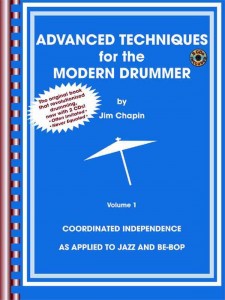 Have you ever followed through on a friend’s recommended book, and upon reading it you oddly just weren’t “feeling it?” These recommended drumming method books are in a similar place. You may not like working on these books. If that happens don’t feel guilty. The main thing is to keep playing while keeping an ear open for your progress. In fact if the ONLY thing that you do is work through these books? Yuck. We are supposed to be musicians, not chimpanzees learning how to move and make a noise! I believe the most important things in studying drumming are to listen harshly to recordings of your favourite musicians AND listening to how you sound when YOU play. Technique will come in its own time.
Have you ever followed through on a friend’s recommended book, and upon reading it you oddly just weren’t “feeling it?” These recommended drumming method books are in a similar place. You may not like working on these books. If that happens don’t feel guilty. The main thing is to keep playing while keeping an ear open for your progress. In fact if the ONLY thing that you do is work through these books? Yuck. We are supposed to be musicians, not chimpanzees learning how to move and make a noise! I believe the most important things in studying drumming are to listen harshly to recordings of your favourite musicians AND listening to how you sound when YOU play. Technique will come in its own time.
Now, continuing on what worked for me. “Rhythmic Patterns” by Joe Cusatis: A perfect book to work through while doing Ted Reed’s “Syncopation” as describe last week’s Technique blog. With Rhythmic Patterns, you play jazz time – again, four on the floor on BD and rocking the toe/heel on your hi-hat foot to have it play 2 & 4. Then you go from time and perform the exercise. Triplets can get you tangled up, so it needs to be taken slowly and then worked faster in speed. I like method books that inspire. Once learned to play at reasonable tempo, you will be able to keep the brain out of the pattern. Then you can extend the solos on the drums with your own ideas while keeping the triplets going. Running into tangled arms or hands? Slow it down and work it back up and you will be able to own Ferris wheels of triplet cities.
One of you might say: “I’m a rock drummer so I don’t need to learn this jazz ride pattern stuff with two and four on the hi hat, let alone four on the floor. That’s stupid!”
Me: Don’t do it then. Enjoy your drumming in the shape and form you wish. The only thing I hope you are doing is holding yourself accountable for the notes by listening to your recordings. Strive for excellence.
BUT… The main benefit of learning the hand patterns with the feet on autopilot is that you will maintain a better balance on the kit. If those feet are really playing on their own, they will help you to keep the tempo steady. In my DVD ”Big Time” I show this in specific detail.
Now it is time to get to Jim Chapin’s bible, “Advanced Techniques For The Modern Drummer.” Bebop was just breaking out in NYC and it was a hyper fertile time for music and drumming. Jim noted what he was hearing and made the single most important book I’ve ever worked on. He once told me he had to carry sticks and pad around town because drummers were giving him grief, that some of his exercises were unplayable! There is one exercise with jazz time and playing ¼ note triplets inside the jazz ride pattern was my single most important exercise because it taught my hands and ears that triplets have a different mysterious flow to them that 8ths or 16ths (duple time) cannot. Playing 3 over 2 was, for me, like cracking the atom open and seeing another Universe! Being able to add a bit of swing feel into some duple (8th note/16th note) grooves adds so much feeling and swagger! Ladies and gentleman of the jury, may I introduce to you Levon Helm, Al Jackson, Ringo Starr and the list goes on and on. Have you heard Omar Hakim solo in a 6 over 4 (or 3 over 2) feel in his clinics? Magnificent.
I promised to discuss a particular book that was pictured in the last blog yet once again I have diverted away to other method books. Bear with me as I continue to attempt staying on point next week.
And finally we can’t forget this. Snare drum/rudimentary solo books! It’s your job now. What is or was your favourite and why? Please share your ideas here. You know where to write for me to see – on my blog at billyward.com or wherever you are reading this.
Thanks
BW
www.twitter.com/billywarddrums
www.facebook.com/billywarddrums
Technique. Part 1, Well, it worked for me…
What I see most often in younger drummer is some combination of the hands not having equal skills as well as simply being unable to travel around the drum kit comfortably and it all holding together. Grip and independence are big problems for many drummers.
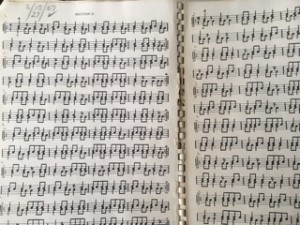 Now, first and foremost to all else, a functioning and comfortable grip that doesn’t hurt you is essential. Working on your grip by studying snare drum exercises and strengthening your hands are what has to happen if you want to get better. If you doubt the solidity of your grip, ask a drummer you admire about theirs, and keep asking until you see progress. It might be an evolving – changing search as you pursue getting better. Be patient and keep digging until you find something that works for your style of playing. Unless we are in the same room together and you ask me about my grip, I cannot help you, so get out there, get bold and ask people to show you their grip!
Now, first and foremost to all else, a functioning and comfortable grip that doesn’t hurt you is essential. Working on your grip by studying snare drum exercises and strengthening your hands are what has to happen if you want to get better. If you doubt the solidity of your grip, ask a drummer you admire about theirs, and keep asking until you see progress. It might be an evolving – changing search as you pursue getting better. Be patient and keep digging until you find something that works for your style of playing. Unless we are in the same room together and you ask me about my grip, I cannot help you, so get out there, get bold and ask people to show you their grip!
As far as independence goes, moving around the kit and playing something that you want to play and not having it all fall apart is a big deal. For now, I’m going to stray away from the usual psychological aspects of drumming and get into the nuts and bolts of my own instruction that I was lucky enough to receive. It will hopefully help you on many levels.
Here goes. First, it should be noted there are many ways to become a musical drummer. It’s possible that a particular style of drumming/music suits you better than another. I can only share my path, which is this. I started playing at 9 years and studied with a local professional drummer, Jack Volk, who was holding down a daily live TV talk show gig in my hometown of Cincinnati, Ohio. He immediately taught grip, reading and rudime
nts from the beginning. The first bible-like book that helped me was “Syncopation” by Ted Reed. I played each exercise with four on the floor (quarter notes on the bass drum) and rock my high hat heel back and forth so it is playing two and four. Heel on one and three, toe on two and four. Have you seen me play with a shaker in my heel and wondered how I could do that so comfortably? This is why.
I’ll continue in present tense (as your teacher if you will)
Read each exercise with right hand on one instrument (floor tom perhaps?) and the other hand on another instrument (snare drum is good). Play it slowly and get it to where you own it. I mean Own. It. Then play other things in similar vein. Yep, make things up. Play time and then go into the exercise without losing flow and come back to time. Use your imagination to expand the notes musically. Continue until you are fully through the book. Whenever you play, keep the two and four on the hat, and the four on the floor with the BD. Patience is required. For proof of this approach being a successful one, go to any video of Steve Gadd, Steve Smith, Steve Jordan… any Steve that is a pro, Ha! Check out their hi-hat foot. Yep, they are using that heel on their left foot to fundamentally assist their timing and groove. The secret to this book (and another that I’ll mention next week) is what is happening with your feet. You must become automatic with your feet being cement solid, as if another person is playing those 4 on the floors and 2 & 4s.
“Oh, I can play that exercise now, in fact I’ve been playing to records and am jamming great with my band! Why should I take the time to involve my feet with such boring, stupid exercises?”
When you get good enough to begin playing with professional players, you will likely have begun to hear microseconds of time. If you want to be able to play with that pro level of timing, you will need your feet to help you through the storms that can happen on the bandstand and in the studio. This book and the next one, when studied this way, will teach you mild versions of independence and most importantly insist that your feet are in the game.
Writing about technical exercises is my least favourite thing to do, perhaps as much as I disliked learning some of those same exercises when I was a kid. But now I am forever grateful that I suffered through them. They are part of my foundation. You are invited to join the party! Next week will be about the book that is pictured here. It is kind of a graduate course to Ted Reed’s “Syncopation” study.
I am very interested to know if this topic is of interest to you. Please send me your comments.
Thanks,
BW
Steering the ship. Two things
Here’s a couple a stories that might influence you in some way. I’ve made plenty of mistakes, but wouldn’t change any of them because, well… here I am. There isn’t an artist out there who doesn’t have a list of failures equal to his list of accomplishments. Your drumming heroes may not speak of the failures but they happened. So… two things.
I began playing drums when I was 9. At 11 years old, I began playing in bands; YMCA concert bands, rock and soul band(s) made up of mostly high schoolers. During that year I met John, a high schooler at the time who turned out to be very influential to me. He loaned me jazz records, which began my music studies – Charlie Parker, Jimmy Smith, Count Basie, and Buddy Rich… I would go to his house and play the Chapin quarter note triplets over jazz ride pattern that I’d just figured out with REAL OLDER MUSICIANS! Holy crap that felt good.
I ended up playing in bands with this person all the way through high, even a bit more. I learned so much from John and am entirely grateful, but one regret that I have is I got “comfortable” playing with this particular group. I stopped learning on the drum set, or you might say “on the job.” I think I stopped listening to the band then also, yet nobody called me on my selfishness. I was practicing like a madman but my playing wasn’t being challenged by anyone and it wasn’t growing.
So, something you might want to note as you swim through your career?
#1. If you might be the best musician in your band or feel bored, look around for a more challenging gig.
I love baseball, I see players who are favourites on the team and in the community. They get traded and boy, they are gone. Like immediately! See ya! On more than one occasion I turned down far more important work because of a conflicting date or dates with my (at that time) current employer. A conflict with one stinking date cost me the better gig entirely. The thing to realize is our employers will sack us immediately, with no regrets. While working your way up the sideman trail, don’t be too loyal. Realize that even if we become successful working sidemen, we are still the catfish at the bottom of the lake.
I recommend approaching your career with the same zeal that you have shown to get better as an individual musician. Relentless pursuit is as necessary as improving your musicality! What about that current gig with lifelong friends? Well, carefully negotiating your relationships is a super important tool. Try to maintain all relationships, but if your heart wants that other gig, and especially if you think it might be a bit over your head….
#2. Take the gig.
See you next week. Please comment to me at my website, billyward.com
Thanks,
Hi everyone. Here’s my second blog and I believe it’s packed with information that could last a lifetime. Now to it…
Music is a big part of my life everyday. Good habits are a powerful life tool. Here’s three things I do that perhaps you can get into and incorporate it into your daily or weekly activity.
ONE. Listen to music. I go to my music service online (so far it is Tidal but I may change at some point) and float around with searches and see what I can find that I’ve not heard. Sometimes it’s yet another jazz record from the 60s or 70s that I once listened to, such as Jimmy Smith Trio with George Benson – highly recommended for tasty feels to copy as well as understanding when to do that fill… Other times it’s something I haven’t heard – today was the Luminaires. Pretty sweet record.
Thinking about music and how to approach it as an author of drum parts is crucial for growing personal technique that is yours and yours only.
TWO. Change the tuning on your snare drum, or if you have time, change the tuning on your entire kit and play play play! You will find new technique that works with that ridiculously higher or lower pitch of your drums. Each area has pluses as well as minuses. Great for learning how to tune the damned things also! In most all recording engineer’s opinions, drummers don’t know how to tune their own instrument! Figure it out! The benefits are extremely high. In my case today, I took a 6.5 X 15 Liberty Drums snare and cranked it as high as it would go. This led to me playing some seriously crazy funky shit for about an hour! Stay fluid with your tuning and approaches to the kit!
THREE. Record yourself. I say those two words to students more than any other. Record yourself often and listen to it as if you are listening to a stranger, not yourself! Imagine it is someone you have great hatred towards – look for the flaws! Now you know what you need to work on, and THIS CAME FROM YOUR SPECIFIC NEED, NOT A BOOK OF EXERCISES.
That’s it for now… PracticePracticeGetbettaGetbettaGetagigGetagig&GetsomeCASH!
– bw
www.billyward.com<http://www.billyward.com>
www.facebook.com/billywarddrums<http://www.facebook.com/billywarddrums>
Hello everyone! I’m here at www.billyward.com as well as facebook.com/billywarddrums.
As I envision this unfolding series of blogs, future topics will include the following and likely more:
– Technique. Both physical as well as “life chops”
– Gear. Possibly how to record drums as well as drums (I’d appreciate feedback on that) – Occasional rants 🙂
– True stories from my career. Some funny, some simply odd, some hard to believe. We will all enjoy this. I’ve got stories.
Who are you? I like to envision you as my friends because we have so much in common. We all love drumming and music! I suspect you already are, or at least certainly wish to be, exceptional. Many of you may feel somewhat close to reaching your next goal in music, but maybe you need a push in one way or another to move forward.
I will tell it like it is based on my perceptions and experience. I hope that when I suggest doing something that you like, you don’t just nod your head and think “That’s a great idea” and then never do it. This is a Nike gig, folks! “Just Do It.” You want be special? Unique? Deeds, not words are what matters, so put the work in. Everyone you look up to, who is great, has put the work in, for hours and hours and day after day. I’m reminded of Mark Craney’s drumstick. It said “Mark Craney – No Excuses”. I suppose that’s the main point of this particular blog – let’s get serious!
Finally. I’m thrilled to announce my blog will appear regularly at mikedolbear.com. I met Mike Dolbear in 2006 where he organized a thrilling teaching tour throughout the UK and we have remained friends to this day. I have “tortured” many UK students at two of his sponsored 5 day intensives and I can’t express how much love I have for those students and fellow teachers from those two events. I am thrilled to be on Mike’s website and hope to remain close to my accomplished students living in the UK and Europe. I’m so psyched! Let’s get serious. Let’s go!
-bw

